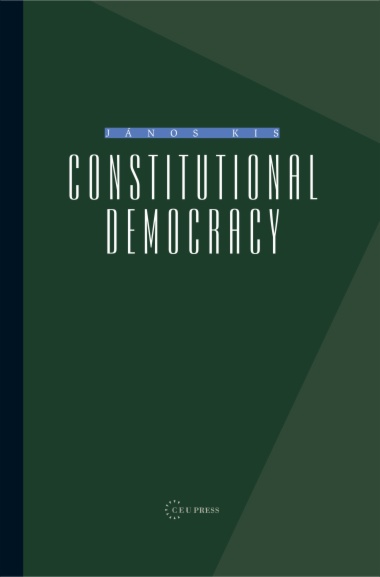Constitutional democracy addresses the widely held belief that liberal democracy embodies an uneasy compromise of incompatible values: those of liberal rights on the one hand, and democratic equality on the other. Liberalism is said to compromise democracy, while democracy is said to endanger the values of liberalism. It is these theses that János Kis examines and tries to refute.Making the assumption that the alleged conflict is to be resolved at the level of institutions, he outlines a new theory of constitutional democracy. A wide range of problems encountered in constitutional democracy are discussed, such as the popular vote, popular sovereignty, and non-elected justices.The volume is composed of three parts. Part One, "Public Good and Civic Virtue", revisits the debate between liberals and democrats on how to interpret the democratic vote. In Part Two, "Liberal Democracy", the author proves that on the level of principles there is no incompatibility between liberalism and democracy and that liberal theory can demonstrate that democratic values follow from fundamental liberal values. In Part Three, "Constitutional Adjudication in a Democracy", the compatibility of democracy and judicial or constitutional review is analyzed and a theory of constitutionalism is outlined.This volume appeals to scholars in political philosophy, political science, and constitutional law, but is also recommended to all those interested in liberal and democratic theory, and the transition to democracy in Central and Eastern Europe.
- Cover
- Title page
- Copyright page
- Table of Contents
- Introduction
- THE COMMON GOOD AND CIVIC VIRTUE
- 1. Liberalism and republicanism
- 2. The preference-aggregating model
- 3. The ethical model: the responsible voter
- 4. The ethical model: the relation between private and communal preferences
- 5. The ethical model: public debate and voting
- 6. On the relation of the two models
- 7. Liberalism and the descriptive claims of the ethical model
- 8. Virtue in politics
- 9. The politics of virtue and personal autonomy
- 10. Concluding remarks
- Notes
- LIBERAL DEMOCRACY – AGAINST THE COMPROMISE THESIS
- 1. Introduction
- 2. The conflict
- 3. Constitutional constraints, constitutional review
- 4. Political equality and rule by the majority
- 5. Equality of votes and equality of voters
- 6. Contractarian theory: the selection of voting rules
- 7. A weakness of contractarian theory
- 8. The typology of preferences
- 9. Filtering the preferences of the contracting parties
- 10. Moral discussion before the contract
- 11. The mandate of the guardians of the constitution
- 12. Summary and restrictions
- Notes
- CONSTITUTIONAL REVIEW
- 1. Introduction
- 1.1. Two Conceptions
- 1.2. Questions of Principle and Questions of Regulation
- 1.3. The Means of Judicial Interpretation of the Constitution
- 1.4. A Brief Overview of What Follows
- 2. Interpreting the constitution
- 2.1. Popular Sovereignty
- 2.2. Only That Which is “in the Text”
- 2.3. Strict Reading
- 2.4. Historical Readings
- 2.5. Substantive Readings: Structural Interpretations
- 2.6. Substantive Interpretations: the Moral Reading
- 2.7. Special Objections: the Structural Reading
- 2.8. Special Objections: the Moral Reading
- 2.9. Substantive Readings: Critical Interpretation
- 2.10. General Objections against Substantive Reading
- 2.11. Constitution Making
- 3. Striking down legislation
- 3.1. Once again on Popular Sovereignty
- 3.2. “The Tyranny of the Majority”
- 3.3. The Power of Self-Binding: Analogies from Individual Action
- 3.4. Communal Agency
- 3.5. Constitutional Self-Binding
- 3.6. Judicial Review, Substantive Reading
- 3.7. The Limits of Constitutional Review
- 3.8. Precautionary Guidelines
- 3.9. Summary
- Notes
- THE LEGACY OF THE FIRST HUNGARIAN CONSTITUTIONAL COURT
- 1. The interpretive practice of the Constitutional Court
- 1.1. The Self-Understanding of the Court: Substantive Reading
- 1.2. Critical Reading: the Abolition of the Death Penalty
- 1.3. Strict Textualism: the Issue of the Legal Status of Fetuses
- 1.4. A Shift in Self-Understanding: Transitional Justice
- 1.5. The Decline of Rights Adjudication
- 1.6. The Upsurge of Welfare Protection
- 1.7. The Paradoxes of Welfare Protection
- 2. Summary and a glance to the Future
- 2.1.Theses
- 2.2. Measuring the First Constitutional Court by Our Theses
- 2.3. From “Legal Revolution” to the “Consolidation of the Rule of Law”
- Notes
- Index
- Back co0ver

